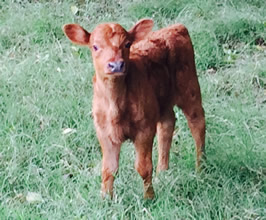“Throwback” is not a genetic term, because it biochemically does not exist. An animal is either heterozygous or homozygous at any location in its genetic code. Some traits are single-gene-traits (influenced by one gene,) and some are influenced my multiple genes.
Before genetic inheritance was understood, the term “throwback” was used in Dexters to describe a genetically normal calf coming out of two dwarf parents, i.e. (animals affected by chondrodysplasia). This was because breeders at the time did not understand that the dwarfs were essentially 1/2 “bulldog”, 1/2 normal. The normal allele was passed on, one from each parent; business as usual. It did not jump in from a rumored ancestor.
A recessive trait is not a “throwback.” Recessive does not mean the allele is passed on with less frequency. It means it can be hidden by another gene, but is still passed on at the same rate. A bull that is black but carries red will pass on the red allele 50% of the time, no matter what. If he is only bred to black cows, the red allele may not show in the offspring as often, but it is there. The red color will only show when the calf also receives a red allele from the dam. In this way, a herd of black animals can suddenly throw a red calf. But this is not a “throwback.” The gene was present in both parents, and did not jump in from a distant ancestor.
Genes get lost . . . forever: A gene can drift out of a herd. Dun drifted out of the Belle Fourche herd because of heavy selection for feet/legs and udders. Basically, in our case, the dun line did not cut the mustard. After several years the herd had only one dun cow and no dun carriers. If the dun cow had been sold, there would have been no dun in the herd and breeding the herd forever would never result in a “throwback” to dun.
Here is another analogy: Say each cell in the body of your new baby calf has 6 feet of DNA. Each cell in the sire’s body had 6 feet of DNA. Each cell in the dam’s body had 6 feet of DNA. When the sire and dam conceived the calf, they each gave the calf 3 feet of their DNA. That means 1/2 of their genetic code was lost in the new calf. Forever. It will not come back later. If every gene from each parent were passed on to the calf, the calf would have 12 feet of DNA. A double-dose of DNA is not compatible with life.
So basically, if a gene is expressed (shows on the animal), it existed in the parents. The only exception would be a dominant fresh mutation, which would be a new change in the DNA; again, not a “throwback” to an ancestor. Although a recessive trait can be hidden for one or more generations, genes themselves do not skip generations.


